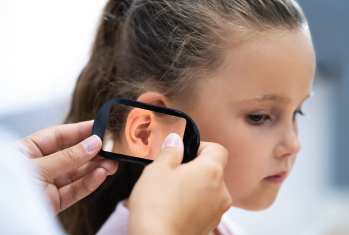
© Andrey_Popov / shutterstock.com
Genetic testing has also recently revealed the cause of periodic fever with aphthous stomatitis, pharyngitis, and cervical adenitis (PFAPA) syndrome. Though researchers and clinicians have long noted strong familial clustering of PFAPA syndrome, earlier attempts at exome sequencing failed to reveal any common mutations (Sci Rep. 2015;5:10200). In 2020, researchers at the National Human Genome Research Institute linked several genes to the condition and discovered genomic similarities among PFAPA syndrome, Behcet’s disease, and canker sores. Because all three conditions share risk loci at IL12A, STAT4, IL10 and CCR1-CCR3, researchers propose calling them Behcet’s spectrum disorders (Proc Natl Acad Sci U S A. 2020;117:14405-14411.) There is also hope that drugs known to reduce inflammatory molecules such as IL12 may be effective in treating these disorders. “I expect we are on the threshold of wider applications for using genetic information for patient management,” Dr. Sie said.
Explore This Issue
February 2022Complex Pediatric Otolaryngology (CPO) Subcertification Underway
Pediatric otolaryngology officially has a new subcertification: complex pediatric otolaryngology (CPO).
On Nov. 2, 2021, 182 candidates took the first COP written certifying examination. Ninety-eight percent passed and earned their CPO subcertification, according to the American Board of Otolaryngology–Head and Neck Surgery.
CPO subcertification is “an indicator to patients, to the public, and to your peers within and outside of otolaryngology that physicians have satisfied all requirements of a rigorous eligibility process and demonstrated acquisition of the knowledge in the care of children with complex otolaryngologic disorders and children with complex medical conditions who also have common otolaryngologic disorders,” said Brian Nussenbaum, MD, the executive director of the American Board of Otolaryngology–Head and Neck Surgery.
The recent CPO subcertification of more than 170 pediatric otolaryngologists is the culmination of more than two decades of work. The effort to create the CPO subcertification started in the 1990s with its approval by the American Board of Medical Specialties (ABMS) and subsequent accreditation of fellowship training programs. Despite concerns about the subcertification’s potential impact on practice and referral patterns, physician collegiality, and physician income—and delays related to the emergence of a global pandemic—the first-ever round of CPO subcertification proceeded relatively smoothly. (For more on its history and criteria, see “Complex Pediatric Otolaryngology Subcertification” in the August 2020 issue of ENTtoday.)
“When we held a town hall meeting in August 2020, there were concerns brought forward about the board introducing a new subcertification in the midst of the pandemic,” Dr. Nussenbaum said. In response to those concerns, the board moved the exam date from July 2021 to November 2021. (“We wanted to be a little further out from the start of the pandemic and realized there would be benefits from having more time,” Dr. Nussenbaum said.) The board also increased the duration of time to attain subcertification from six to seven years for the training pathway and from seven to nine years on the practice pathway, with the practice pathway now closing in 2030 rather than 2028. Additionally, in response to reports of lower-than-normal case volumes during the pandemic, individuals were allowed to submit letters requesting an extra year to attain the minimum required case volume.
We’re evolving toward the ability to have targeted treatment options, and I think that’s really going to change treatment over the next five or 10 years. I’m putting myself out of business. —Jonathan Perkins, DO
“We did receive a few requests for a one-year extension, but none of those requests had anything to do with COVID-19 effects on case numbers,” Dr. Nussenbaum said. “They were very valid requests, however, and we did approve them.”
Nearly two-thirds of the first group of CPO subcertified pediatric otolaryngologists qualified via the practice pathway, which requires physicians to demonstrate management of 100 index cases within four consecutive years proximate to application. The remaining third qualified via the training pathway, which requires management of 50 index cases within two consecutive years proximate to application. Dr. Nussenbaum said that the board expects that approximately 50% or more of applicants will approach subcertification via the practice pathway for the next few years.
“We anticipate that around year four or five, we’ll probably start seeing more applicants from the training pathway than the practice pathway,” he said. “Once the practice pathway closes in 2030, CPO subcertification will be solely via the training pathway and we anticipate somewhere between 30 to 40 candidates per year.”
“Even with the introduction of CPO subcertification, the great majority of pediatric otolaryngology diseases and disorders in children can still be taken care of by those with primary board certification in otolaryngology–head and neck surgery,” he said. This is emphasized in a joint statement from the American Board of Otolaryngology–Head and Neck Surgery, the American Academy of Otolaryngology–Head and Neck Surgery, and the American Society of Pediatric Otolaryngology.
The next CPO subcertification exam is scheduled for Oct. 25, 2022. The application process is expected to open on Feb. 7, 2022.